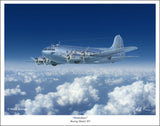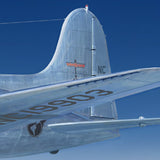The Boeing Model 307 Stratoliner was derived from the B-17 Flying Fortress. It entered service in 1940 and was the first airliner in service with a pressurized cabin. The airplane also had supercharged engines which gave it a 220 MPH cruising speed and 20,000 ft service ceiling enabling it to cruise at altitudes above the weather. When it initially entered commercial service it had a capacity for 33 passengers. Later modifications eventually increased seating to 60.
The major American airlines that used the Stratoliner were Pan American and Transcontinental & Western Air (TWA). The TWA aircraft were pressed into service with the USAAF in 1942 because transports were desperately needed during World War II. They were specially modified and carried the designation of C-75. After three years they were sold back to TWA who had them reconverted back to commercial service.
With the advent of the larger DC-6 and Constellation airliners, the Stratoliner became less competitive. Aircraft were sold to other operators such as the French operator Aigle Azur. The last flying example was lost in a wreck in 1975.
There is one surviving complete airplane (NC19903) which was restored to flying condition and preserved at the Smithsonian's Steven F. Udvar-Hazy Center.
The major American airlines that used the Stratoliner were Pan American and Transcontinental & Western Air (TWA). The TWA aircraft were pressed into service with the USAAF in 1942 because transports were desperately needed during World War II. They were specially modified and carried the designation of C-75. After three years they were sold back to TWA who had them reconverted back to commercial service.
With the advent of the larger DC-6 and Constellation airliners, the Stratoliner became less competitive. Aircraft were sold to other operators such as the French operator Aigle Azur. The last flying example was lost in a wreck in 1975.
There is one surviving complete airplane (NC19903) which was restored to flying condition and preserved at the Smithsonian's Steven F. Udvar-Hazy Center.








